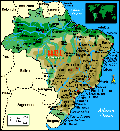
Early Relations and the Question of Fascism
Getulio Vargas and the Estado Novo
On a global scale the 1930's experienced an enormous rise in Fascism.
Mussolini in Italy, Hitler in Germany, Franco in Spain, and various fascist
regimes in Latin America all solidified their power during this time.
Brazil, however, gave birth to a new type of dictator: Getulio Vargas.
Initially assuming power in the "Revolution of 1930" Vargas was lovingly
named "pai dos pobres," father of the poor. Vargas' ideology was nonexistent,
and his only methodology involved compromise. He favored labor reform
and sought to revolutionize Brazilian politics in order to bring them
into the twentieth century. Hence, in 1937, with no chance of re-election
due to local politics, Vargas declared himself dictator of Brazil, and
established the "Estado Novo" or New State. As far as the American government
was concerned, specific policies of Vargas' Estado Novo were inconsequential.
The bottom line was that Brazil was now a dictatorship, and therefore
on its was to becoming a member of the Axis powers. United States public
opinion was swayed by the New York Times, which ran nineteen stories on
Brazil in November of 1937, stating that although Vargas did not represent
European fascism, he was indeed still a fascist. The Times also remarked
that the United States may lose a considerable share of the market in
Brazil to the European Fascists. Until 1939 coffee constituted the bulk
of Brazilian-American trade relations. American exporters, however, were
looking forward to exploring new relations with the industry-minded Brazilian
leader.
Brazil's Fifth Column and Trade
Two realities disturbed the American government
with regards to
Brazil: first was the German population in Brazil, and second was German-Brazilian trade relations. In 1938 the German-born population in Brazil numbered 220,000, "concentrated in the three southern states of Rio Grande do Sul, Santa Catarina, and Parana." What bothered the United States government about the German population in Brazil was not their political mobilization, but their preservation of a German lifestyle. Even to this day there are towns in Brazil that contain street signs written in German. In 1938 there was no attempt to integrate into Brazilian society by the German population, and a majority remained in small, private farming communities. In addition to preservation of a German lifestyle, National Socialist Organizations sprouted up, beginning with Hitler's rise to power in 1933. These organizations were well established by 1938 and their primary function was to "express their solidarity with the fatherland." Three years after the conception of the first pro-German organization in 1933, a solidarity movement among the various groups took place. The cohesive force that bonded the groups was Nazism. All of the above aspects to the German-Brazilian population contributed to a general suspicion by the American government. The second alarming factor for the United States government was Brazil's current trade relations with Germany, and ultimately with all of Europe. Americans sought not only new trade relations with Brazil, but sole rights to trade to with Latin America's most lucrative state. The primary subject of trade was military equipment and arms, which, in 1937, "Vargas suggested all forms of military and naval cooperation, including construction of a naval base in a Brazilian port for American use." In 1937 the American government was not willing to venture that far into relations with Brazil. Yet in 1939, upon Hitler's invasion of Poland, the American tune changed drastically. Between 1937 and 1939, the American unable to meet the pricing of European nations and the payment plans of Brazil, Getulio Vargas shopped around for the deals he knew he could find in Europe. An initial purchase of $55,000,000 was placed with Germany for "artillery pieces and accessories" in March of 1938, "with future interests under consideration." The American fear was that German military officials and advisors would follow the equipment. Future plans included the spending of "$100,000,000 on a five-year arms program," and the recipient of this contract was yet to be determined. However, looking at past purchases from Czechoslovakia, Italy, and Germany, US ambassador to Brazil, Caffery, feared the contract would lead to fascist domination in Brazil. Furthermore, with Argentina under the leadership of a dictator and full-cooperation with the Germans, the US government also predicted future Axis domination of all of Latin America.
